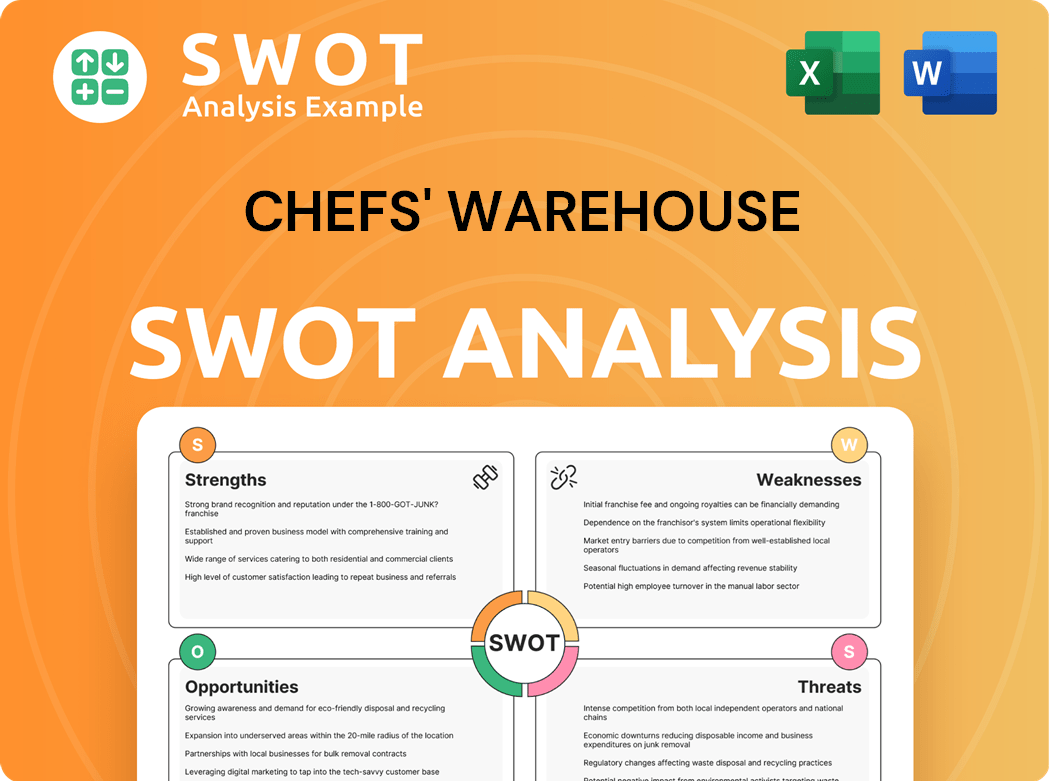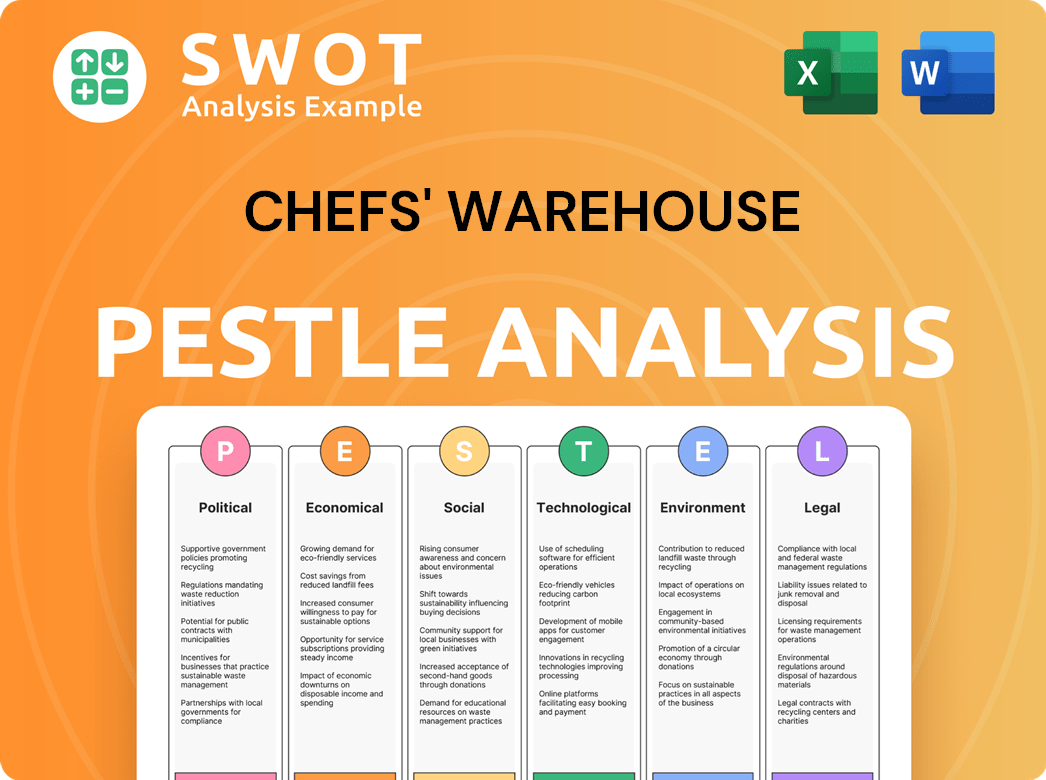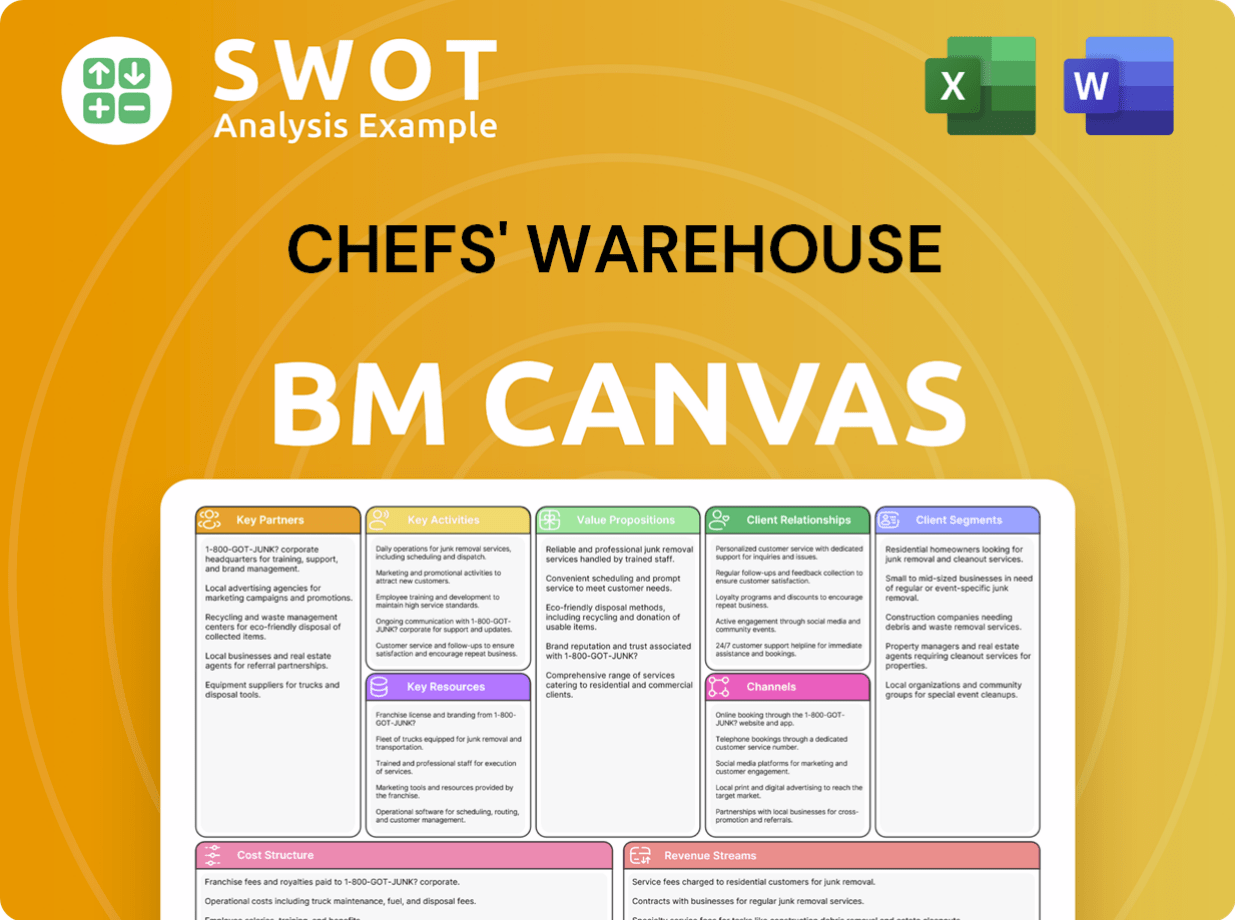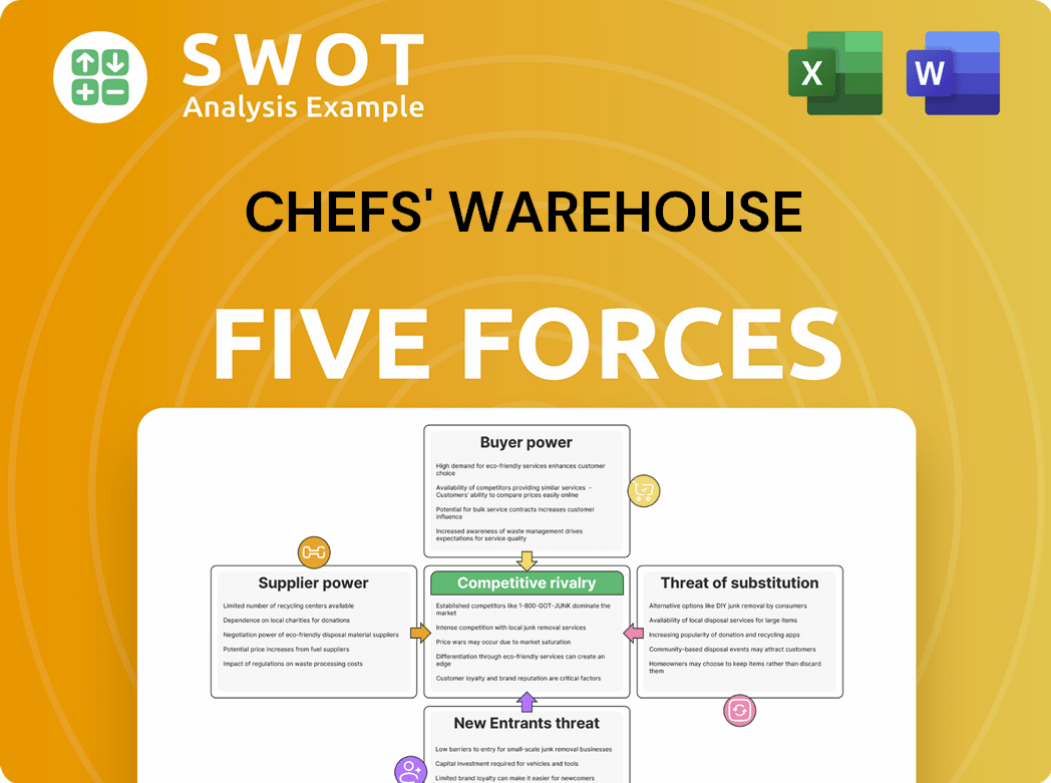Chefs' Warehouse Bundle
Who Does Chefs' Warehouse Really Serve?
In the dynamic world of foodservice distribution, understanding Chefs' Warehouse SWOT Analysis customer demographics and target markets is paramount. The Chefs' Warehouse, a leader in specialty food distribution, has evolved significantly since its inception, reflecting the ever-changing demands of the culinary landscape. This evolution necessitates a deep dive into the company's customer base and how it strategically caters to their unique needs.

From its humble beginnings supplying local eateries, The Chefs' Warehouse now serves over 50,000 customer locations, making a detailed examination of its Chefs' Warehouse customers and Chefs' Warehouse target market crucial. This analysis will explore the company's customer profile, including Chefs' Warehouse customer demographics, purchasing behavior, and satisfaction levels within the restaurant industry. Understanding who The Chefs' Warehouse's ideal customers are is essential for both strategic planning and continued success in foodservice distribution.
Who Are Chefs' Warehouse’s Main Customers?
Understanding the Owners & Shareholders of Chefs' Warehouse customer demographics is crucial for analyzing its market position. The company operates primarily in a Business-to-Business (B2B) model, focusing on the needs of culinary professionals. This strategic focus shapes its target market and influences its business strategies.
The core of the Chefs' Warehouse customer base comprises chefs and operators within the foodservice distribution sector. This includes fine-dining restaurants, hotels, casinos, and catering companies. The company's customer segmentation also extends to culinary schools, bakeries, and specialty food stores, highlighting a broad reach within the culinary world.
While the primary focus is B2B, the Allen Brothers subsidiary offers a direct-to-consumer (B2C) channel. This smaller segment markets center-of-the-plate proteins through mail and e-commerce platforms, diversifying its customer base. This dual approach allows Chefs' Warehouse to cater to both professional and individual consumer needs.
The primary customer base includes chefs and operators in fine-dining restaurants, hotels, and casinos. Culinary schools, bakeries, and specialty food stores also form part of their target market. They also have a direct-to-consumer segment through their Allen Brothers subsidiary.
The main customer segments include fine-dining restaurants, hotels, casinos, and catering companies. Culinary schools and specialty food stores are also served. The company focuses on menu-driven independent restaurants to expand its market share.
As of February 25, 2025, Chefs' Warehouse serves over 50,000 core customer locations, excluding its direct-to-consumer business. The company's unique customer base increased by 4.5% in Q1 2025 compared to Q1 2024, demonstrating continued growth. The company's success in Q4 2024 was driven by its upscale-casual to higher-end dining customer base.
- Focus on menu-driven independent restaurants.
- Strategic acquisitions like GreenLeaf and Hardie's Fresh Foods.
- Expansion of distribution capabilities and reach.
- Continued growth in customer base.
Chefs' Warehouse SWOT Analysis
- Complete SWOT Breakdown
- Fully Customizable
- Editable in Excel & Word
- Professional Formatting
- Investor-Ready Format

What Do Chefs' Warehouse’s Customers Want?
Understanding the needs and preferences of its customers is crucial for the success of The Chefs' Warehouse. The company's target market primarily consists of culinary professionals who demand high-quality ingredients and reliable service. Catering to these specific needs allows the company to maintain strong customer relationships and drive sales within the competitive foodservice distribution landscape.
The Chefs' Warehouse focuses on providing specialty ingredients that inspire culinary creativity. Their customers, including chefs and restaurant owners, seek unique and superior products to elevate their menus. This focus on quality and variety is a key factor in attracting and retaining customers within the restaurant industry.
Customer demographics for The Chefs' Warehouse encompass a range of culinary professionals, from executive chefs to restaurant owners. The company's customer base is diverse, with a focus on those who value premium ingredients and exceptional service. Understanding these customer needs and wants is essential for tailoring product offerings and marketing strategies.
Chefs' primary needs revolve around access to high-quality, specialty ingredients. Their motivations include culinary creativity and the desire to maintain high standards. The company addresses these needs by offering a wide range of products.
The company provides an extensive portfolio of over 88,000 SKUs. This includes artisan charcuterie, specialty cheeses, and unique oils. The diverse product range caters to various culinary needs.
Purchasing decisions are driven by the demand for specific, often rare or seasonal, items. Product quality and consistency are critical. The company's ability to provide a wide range of specialized goods influences purchasing decisions.
The company emphasizes a 'white glove service' model. Dedicated sales representatives offer tailored support. This personalized service streamlines the ordering process.
Approximately 58% of customers ordering through domestic specialty locations use the online platform as of Q1 2025. This is an increase from 56% at year-end 2024 and 48% at year-end 2023, showing a preference for digital ordering.
The company addresses supply chain complexities and the need for just-in-time delivery. Their robust distribution network and operational efficiencies are crucial for meeting these demands.
The company's ability to meet the needs of its target audience is a key factor in its success. Growth Strategy of Chefs' Warehouse highlights the importance of understanding customer needs. The company's focus on quality, service, and adapting to market trends positions it well within the foodservice distribution sector.
Feedback and market trends influence product development. There is a rising interest in healthy eating, plant-based options, and global flavors. The company introduces new products that address regional trends and preferences.
- The specialty foods market is trending towards high-quality and innovative products.
- This includes plant-based, convenience, better-for-you, and non-GMO items.
- The company continuously evaluates and introduces new products.
- This ensures they remain at the forefront of broader culinary trends.
Chefs' Warehouse PESTLE Analysis
- Covers All 6 PESTLE Categories
- No Research Needed – Save Hours of Work
- Built by Experts, Trusted by Consultants
- Instant Download, Ready to Use
- 100% Editable, Fully Customizable

Where does Chefs' Warehouse operate?
The Chefs' Warehouse has a robust geographical market presence, primarily focused on metropolitan areas across the United States, Canada, and the Middle East. As of December 27, 2024, the company's operations span 23 primary geographic markets, supported by approximately 49 distribution facilities. This extensive network facilitates a distribution capacity of 3.0 million square feet.
Their strategic footprint includes a strong presence in the U.S., particularly along the East, Midwest, and West coasts. Recent expansions in fiscal 2024 and early 2025, such as new distribution centers in key cities, highlight their commitment to growth. Acquisitions, like GreenLeaf and Hardie's Fresh Foods, have further strengthened their specialty produce distribution capabilities. These moves are part of a broader strategy to cater to the needs of the Chefs' Warehouse customers.
The company's international presence, including the Middle East and Canada, provides diversification and a hedge against regional market fluctuations. They continuously introduce new products to address regional trends and preferences, ensuring they remain at the forefront of culinary developments. The company's sales force in high-growth investment markets has seen an average annual growth of approximately 20% to 25% since the end of 2021. This localized sales effort, combined with strategic infrastructure investments, supports their success in diverse markets. For more insights, check out the Brief History of Chefs' Warehouse.
The United States represents a significant portion of the company's operations. Key areas include the East, Midwest, and West coasts. Strategic expansions and acquisitions bolster their distribution capabilities. They are focused on the Restaurant industry.
The company has a presence in the Middle East and Canada, offering diversification. They adapt their offerings to meet regional demands and preferences. This strategy helps them to reach a wider Chefs' Warehouse target market.
Acquisitions like GreenLeaf and Hardie's Fresh Foods have enhanced their specialty produce distribution. New distribution centers in major cities support their growth strategy. These moves help them to better serve Culinary professionals.
The company anticipates net sales for fiscal year 2025 to be between $3.96 billion and $4.04 billion. This projection reflects their strategic market positioning and growth initiatives. This highlights the company's focus on Foodservice distribution.
Chefs' Warehouse Business Model Canvas
- Complete 9-Block Business Model Canvas
- Effortlessly Communicate Your Business Strategy
- Investor-Ready BMC Format
- 100% Editable and Customizable
- Clear and Structured Layout

How Does Chefs' Warehouse Win & Keep Customers?
The Chefs' Warehouse employs a comprehensive strategy for both acquiring and retaining customers within the foodservice distribution sector. This approach is crucial for understanding the company's overall market position and its ability to serve its target market. The strategies focus on expanding market share and fostering strong customer relationships with culinary professionals.
Customer acquisition is primarily driven by expanding its presence within existing markets and entering new ones. This involves targeting a broad range of establishments, from independent restaurants to hotels and cruise lines. Strategic acquisitions also play a key role in broadening the customer base and product offerings. These efforts are supported by a growing sales force and targeted expansion in high-growth areas.
Customer retention is a cornerstone of the company's strategy, emphasizing personalized service and digital innovation. Dedicated sales representatives, digital platforms for streamlined ordering, and data-driven insights are all leveraged to enhance customer satisfaction and drive loyalty. The company's focus on customer needs and wants is reflected in its high retention rate and continued investment in customer-centric solutions.
The company focuses on increasing its market share within the existing markets by cultivating new customer relationships. This is achieved through the continued penetration of menu-driven independent restaurants, fine dining establishments, and other culinary-focused businesses. They also use strategic acquisitions to broaden their customer base and product offerings.
The sales force, excluding acquisitions, has grown by approximately 10% annually since the end of 2021. High-growth markets like Florida, the Middle East, and California have seen even greater expansion, with growth rates between 20% and 25% annually. This expansion is a key element in acquiring new customers.
The company emphasizes a 'customer-centric ethos' by pairing each customer with a dedicated sales representative. This approach provides tailored support and guidance, enhancing customer satisfaction. This high-touch model is a core element of the customer retention strategy.
Investments in digital platforms and technology solutions streamline ordering and improve the customer experience. Approximately 58% of customers ordering through domestic specialty locations do so online as of Q1 2025, up from 48% at the end of 2023. These investments improve profitability by driving online order adoption, enhancing customer-facing functionality, and providing real-time data analytics.
The company's success in customer retention is evident in its reported rate of 87%. This high rate is attributed to specialized product offerings and personalized service. Looking ahead to 2025, the company aims to improve customer retention further, expecting a more moderate increase in order frequency compared to 2024 as higher customer acquisition rates also impact the trend. To understand the competitive landscape, it's helpful to compare the strategies of Competitors Landscape of Chefs' Warehouse.
Chefs' Warehouse Porter's Five Forces Analysis
- Covers All 5 Competitive Forces in Detail
- Structured for Consultants, Students, and Founders
- 100% Editable in Microsoft Word & Excel
- Instant Digital Download – Use Immediately
- Compatible with Mac & PC – Fully Unlocked

Related Blogs
- What are Mission Vision & Core Values of Chefs' Warehouse Company?
- What is Competitive Landscape of Chefs' Warehouse Company?
- What is Growth Strategy and Future Prospects of Chefs' Warehouse Company?
- How Does Chefs' Warehouse Company Work?
- What is Sales and Marketing Strategy of Chefs' Warehouse Company?
- What is Brief History of Chefs' Warehouse Company?
- Who Owns Chefs' Warehouse Company?
Disclaimer
All information, articles, and product details provided on this website are for general informational and educational purposes only. We do not claim any ownership over, nor do we intend to infringe upon, any trademarks, copyrights, logos, brand names, or other intellectual property mentioned or depicted on this site. Such intellectual property remains the property of its respective owners, and any references here are made solely for identification or informational purposes, without implying any affiliation, endorsement, or partnership.
We make no representations or warranties, express or implied, regarding the accuracy, completeness, or suitability of any content or products presented. Nothing on this website should be construed as legal, tax, investment, financial, medical, or other professional advice. In addition, no part of this site—including articles or product references—constitutes a solicitation, recommendation, endorsement, advertisement, or offer to buy or sell any securities, franchises, or other financial instruments, particularly in jurisdictions where such activity would be unlawful.
All content is of a general nature and may not address the specific circumstances of any individual or entity. It is not a substitute for professional advice or services. Any actions you take based on the information provided here are strictly at your own risk. You accept full responsibility for any decisions or outcomes arising from your use of this website and agree to release us from any liability in connection with your use of, or reliance upon, the content or products found herein.